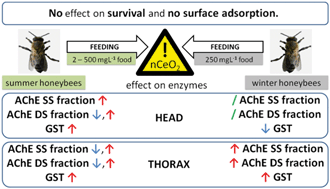当前位置:
X-MOL 学术
›
Environ. Sci.: Nano
›
论文详情
Our official English website, www.x-mol.net, welcomes your
feedback! (Note: you will need to create a separate account there.)
Cerium(iv) oxide nanoparticles induce sublethal changes in honeybees after chronic exposure†
Environmental Science: Nano ( IF 5.8 ) Pub Date : 2017-10-04 00:00:00 , DOI: 10.1039/c7en00596b Monika Kos 1, 2, 3, 4 , Anita Jemec Kokalj 1, 2, 3, 4 , Gordana Glavan 1, 2, 3, 4 , Gregor Marolt 2, 3, 4, 5 , Primož Zidar 1, 2, 3, 4 , Janko Božič 1, 2, 3, 4 , Sara Novak 1, 2, 3, 4 , Damjana Drobne 1, 2, 3, 4
Environmental Science: Nano ( IF 5.8 ) Pub Date : 2017-10-04 00:00:00 , DOI: 10.1039/c7en00596b Monika Kos 1, 2, 3, 4 , Anita Jemec Kokalj 1, 2, 3, 4 , Gordana Glavan 1, 2, 3, 4 , Gregor Marolt 2, 3, 4, 5 , Primož Zidar 1, 2, 3, 4 , Janko Božič 1, 2, 3, 4 , Sara Novak 1, 2, 3, 4 , Damjana Drobne 1, 2, 3, 4
Affiliation

|
The high annual production and use of cerium(IV) oxide nanoparticles (nCeO2s) may lead to their atmospheric release and substantial deposition on plants. This poses a potential threat to pollinators. We investigated the effects of nCeO2-spiked food (2–500 mg L−1) on summer and winter honeybees (Apis mellifera carnica) after chronic 9 days' oral exposure. Acetylcholinesterase (AChE) and glutathione S-transferase (GST) activities were measured in different body compartments (heads, thoraces, and haemolymph). The activity of AChE was assessed in salt-soluble (SS) (containing soluble and membrane AChE) and detergent-soluble (DS) (predominantly membrane-bound AChE) fractions. Exposure of honeybees to nCeO2-spiked food had no significant effects on survival up to 500 mg L−1 (<10%), while significant biochemical alterations were evidenced already at 2 mg L−1. In summer honeybees, a significant increase in the activities of AChE in the SS fraction and GST was found, while AChE activity in DS fractions was decreased at nearly all exposure concentrations. An exception was the 250 mg L−1 exposure, where AChE activity in DS fractions was increased. The alteration of AChE in the DS fraction could be symptomatic for the affected neuronal system, while alterations of GST activity indicate detoxification processes. An apparent difference in response to nCeO2 was evidenced between the summer and winter honeybees, which is in line with their different physiology. We ascribe most of the observed effects to particulate nCeO2 because a negligible presence of Ce ion species was found in their food. We conclude that nCeO2 release into the environment, especially atmospherically deposited material, is a potential risk to honeybees.
中文翻译:

慢性暴露后,氧化 铈(iv)纳米颗粒诱导蜜蜂的亚致死性变化†
氧化铈(IV)纳米颗粒(nCeO 2 s)的高年产量和使用量可能导致其大气释放和大量沉积在植物上。这对传粉媒介构成了潜在威胁。我们调查了长期口服9天后,掺有nCeO 2的食物(2–500 mg L -1)对夏季和冬季蜜蜂(蜜蜂)的影响。乙酰胆碱酯酶(AChE)和谷胱甘肽S在不同的身体部位(头部,胸廓和血淋巴)测量了β-转移酶(GST)的活性。在盐溶性(SS)(包含可溶性和膜性AChE)和去污剂可溶性(DS)(主要是膜结合性AChE)馏分中评估AChE的活性。蜜蜂暴露于掺有nCeO 2的食物中,对高达500 mg L -1(<10%)的存活率没有显着影响,而已经证明在2 mg L -1时有明显的生化改变。在夏季蜜蜂中,发现SS组分和GST中的AChE活性显着增加,而DS组分中的AChE活性在几乎所有暴露浓度下均下降。一个例外是250 mg L -1暴露,DS馏分中的AChE活性增加。DS级分中AChE的改变可能是受影响的神经元系统的症状,而GST活性的改变表明排毒过程。夏季和冬季蜜蜂之间对nCeO 2的响应存在明显差异,这与它们的不同生理学相符。我们将大多数观察到的影响归因于颗粒nCeO 2,因为在他们的食物中发现了可忽略不计的Ce离子种类。我们得出的结论是,nCeO 2释放到环境中,尤其是大气中沉积的物质,是蜜蜂的潜在风险。
更新日期:2017-10-04
中文翻译:

慢性暴露后,氧化 铈(iv)纳米颗粒诱导蜜蜂的亚致死性变化†
氧化铈(IV)纳米颗粒(nCeO 2 s)的高年产量和使用量可能导致其大气释放和大量沉积在植物上。这对传粉媒介构成了潜在威胁。我们调查了长期口服9天后,掺有nCeO 2的食物(2–500 mg L -1)对夏季和冬季蜜蜂(蜜蜂)的影响。乙酰胆碱酯酶(AChE)和谷胱甘肽S在不同的身体部位(头部,胸廓和血淋巴)测量了β-转移酶(GST)的活性。在盐溶性(SS)(包含可溶性和膜性AChE)和去污剂可溶性(DS)(主要是膜结合性AChE)馏分中评估AChE的活性。蜜蜂暴露于掺有nCeO 2的食物中,对高达500 mg L -1(<10%)的存活率没有显着影响,而已经证明在2 mg L -1时有明显的生化改变。在夏季蜜蜂中,发现SS组分和GST中的AChE活性显着增加,而DS组分中的AChE活性在几乎所有暴露浓度下均下降。一个例外是250 mg L -1暴露,DS馏分中的AChE活性增加。DS级分中AChE的改变可能是受影响的神经元系统的症状,而GST活性的改变表明排毒过程。夏季和冬季蜜蜂之间对nCeO 2的响应存在明显差异,这与它们的不同生理学相符。我们将大多数观察到的影响归因于颗粒nCeO 2,因为在他们的食物中发现了可忽略不计的Ce离子种类。我们得出的结论是,nCeO 2释放到环境中,尤其是大气中沉积的物质,是蜜蜂的潜在风险。











































 京公网安备 11010802027423号
京公网安备 11010802027423号